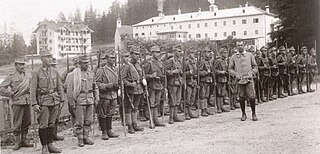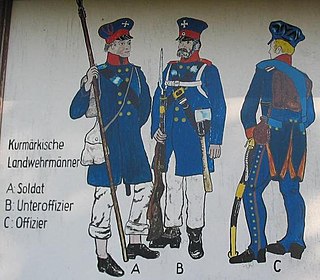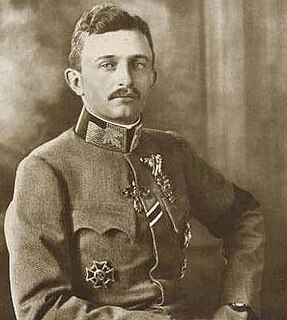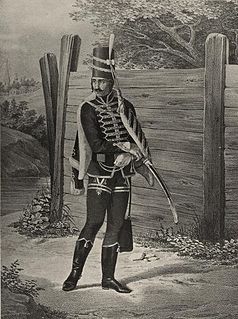 W
WThe Austro-Hungarian Army was the ground force of the Austro-Hungarian Dual Monarchy from 1867 to 1918. It was composed of three parts: the joint army, the Imperial Austrian Landwehr, and the Royal Hungarian Honvéd.
 W
WAssent, also assentation was the process of incorporation (recruitment) of persons liable to military service into the former Austro-Hungarian Army (1867–1918). It was also the designation for the purchase of horses by the so-called remount-commission. The word comes from the Latin as-sentãrĩ, and means literal agree to, accede to, or to determine someone fit for a defined purpose.
 W
WThe Common Army as it was officially designated by the Imperial and Royal Military Administration, was the largest part of the Austro-Hungarian land forces from 1867 to 1914, the other two elements being the Imperial-Royal Landwehr and the Royal Hungarian Landwehr. However, it was simply known as the Army (Heer) by the Emperor and in peacetime laws, and, after 1918, colloquially called the k.u.k. Armee.
 W
WThe Alpine companies were specialized mountain infantry troops that were part of the Austro-Hungarian land forces during the First World War.
 W
WStormtroopers were specialist soldiers of the German Army. In the last years of World War I, Stoßtruppen were trained to use infiltration tactics – part of the Germans' improved method of attack on enemy trenches. The German Empire entered the war certain that the conflict would be won in the course of great military campaigns, thus relegating results obtained during individual clashes to the background; consequently the best officers, concentrated in the German General Staff, placed their attention on maneuver warfare and the rational exploitation of railways, rather than concentrating on the conduct of battles: this attitude gave a direct contribution to operational victories of Germany in Russia, Romania, Serbia and Italy, but it resulted in failure in the West. Thus the German officers on the Western Front found themselves in the need of resolving the static situation caused by trench warfare on the battlefield.
 W
WThe Bosnian-Herzegovinian Infantry, commonly called the Bosniaken, were a branch of the Austro-Hungarian Army. Recruited from outside the Austrian and Hungarian regions of the Dual-Monarchy, with a significant proportion of Muslim personnel (31.04%), these regiments enjoyed a special status. They had their own distinctive uniforms and were given their own numbering sequence within the Common Army (KuK).
 W
WPaul Freiherr Puhallo von Brlog was a general of Austria-Hungary. During World War I, he commanded the Austro-Hungarian Army's 3rd and 1st Armies.
 W
WThe following is a list of Austro-Hungarian colonel generals of the Austro-Hungarian Army.
 W
WTogether with the Hussars and Uhlans, the Imperial and Royal Dragoons made up the cavalry of the Austro-Hungarian Army from 1867 to 1914.
 W
WFeuerwerker are specialists in the armed forces of German-speaking countries responsible for the maintenance of ammunition.
 W
WThe First Cadre Company was a Polish military formation created in the Austro-Hungarian Army at the outbreak of World War I. The company was founded by Józef Piłsudski on August 3, 1914 in Kraków. It was the predecessor of the Polish Legions, and formed the core of the Polish Legions' First Brigade during World War I.
 W
WThe Federal Gendarmerie was an Austrian federal police agency. It was responsible for approximately two thirds of the population on approximately 98% of Austrian national territory, alongside the Federal Safety Guard Corps (Bundessicherheitswachekorps) and Detective Corps (Kriminalbeamtenkorps). All Austrian law enforcement agencies were merged into the Federal Police (Bundespolizei) agency, with effect from 1 July 2005.
 W
WTogether with the Dragoons and Uhlans, the Imperial and Royal Hussars, made up the cavalry of the Austro-Hungarian Army from 1867 to 1918, both in the Common Army and in the Hungarian Landwehr, where they were known as the Royal Hungarian Hussars.
 W
WThe Imperial-Royal Landwehr, also called the Austrian Landwehr, was the territorial army of the Cisleithanian or Austrian half of the Austro-Hungarian Empire from 1869 to 1918. Its counterpart was the Royal Hungarian Landwehr. The two Landwehrs, together with the Common Army and the Imperial and Royal Navy, made up the armed forces of Austria-Hungary.
 W
WLandwehr, or Landeswehr, is a German language term used in referring to certain national armies, or militias found in nineteenth- and early twentieth-century Europe. In different context it refers to large-scale, low-strength fortifications. In German, the word means "defence of the country"; but the term as applied to an insurrectional militia is very ancient, and lantveri are mentioned in Baluzii Capitularia, as quoted in Hallam's Middle Ages, i. 262, 10th edition.
 W
WThe Imperial-Royal Mountain Troops were founded in 1906 as part of the Austrian Landwehr, the territorial army of the Cisleithanian half of the Austro-Hungarian Empire. As a result, the abbreviation "k.k." was used and not "k.u.k." which would have implied a connexion with the Hungarian half of the Empire.
 W
WOberarzt, literally meaning "senior physician," in English known as first lieutenant (Dr.), was a military commissioned officer rank in the Austro-Hungarian Common Army until 1918, and in the German Reichswehr and Wehrmacht until 1945.
 W
WThe Paroli was initially the designation for the coloured gorget patches of the Austro-Hungarian Army. It is applied on the gorget of a uniform coat or jacket and the battle-dress blouse. The Parolis indicated the egalisation colour and served as discrimination criteria of the 102 infantry regiments of the Austro-Hungarian Army, as well as dragoon regiment and the regiment of the uhlans. In other German-speaking armed forces, the designation was called Kragenpatte, Kragenspiegel, or Arabesque.
 W
WPatrouilleführer was a military rank of the k.u.k. Austro-Hungarian Army (1867–1918). It might be comparable to enlisted men OR2/ Private 1st class ranks in Anglophone armed forces.
 W
WThe Romanian Volunteer Corps in Russia, or Volunteer Corps of Transylvanians-Bukovinians, was a military formation of World War I, created from ethnic Romanian prisoners of war held by Russia. Officially established in February 1917, it comprised abjurers of the Austro-Hungarian Army, mainly contingents from Transylvania and Bukovina. These had been obliged to fight against Romania, and, once in Russian custody, volunteered for service against the Central Powers. As campaigners for self-determination and union with Romania, they passed political resolutions which, in both tone and scope, announced those adopted on Union Day 1918.
 W
WThe Royal Croatian Home Guard was the Croatian-Slavonian army section of the Royal Hungarian Landwehr, which existed from 1868 to 1918. The force was created by decree of the Croatian Parliament on December 5, 1868 as a result of the Croatian–Hungarian Settlement.
 W
WThe Royal Hungarian Honvéd, Royal Hungarian Honved or Royal Hungarian Landwehr, commonly known as the Honved, Honvéd or in Hungarian, Honvédség, was one of the four armed forces of Austria-Hungary from 1867 to 1918. The others were its counterpart the Austrian Landwehr, the Common Army and the Imperial and Royal Navy. The word "honvéd" means an enlisted private without a rank, literally "Defender of the Homeland". "Honvédség" is degree of the noun and refers to the community, institution of these soldiers.
 W
WThe Rumburk rebellion was a mutiny by Czech soldiers in the Austro-Hungarian Army during the First World War. It took place on 21 May 1918 in the town of Rumburk in North Bohemia.
 W
WThe Standschützen were originally rifle guilds and rifle companies that had been formed in the 15th and 16th centuries, and were involved time and again in military operations within the borders of the Austrian County of Tyrol. A Standschütze was a member of a Schützenstand, into which he was enrolled, which automatically committed him to the voluntary, military protection of the state of Tyrol. In effect they were a type of Tyrolean local militia or home guard.
 W
WLegion of Ukrainian Sich Riflemen was a Ukrainian unit within the Austro-Hungarian Army during the First World War.
 W
WPatrouilleführer was a military rank of the k.u.k. Austro-Hungarian Army (1867–1918). It might be comparable to enlisted men OR2/ Private 1st class ranks in Anglophone armed forces.
 W
WWachtmeister is a military rank of non-commissioned officers (NCO) in Austria and Switzerland. The Wachtmeister was initially responsible for the guard duty of the army. Later, it became the Feldwebel equivalent NCO-grade of the cavalry and artillery. Besides Austria and Switzerland today, the rank was also used elsewhere, for example in Germany, Russia, and Poland (wachmistrz).
 W
WWaffenfarbe(n), also Egalisierungsfarbe(n), are traditional used by the Federal Army of the Republic of Austria. The collar patches of the Federal Army report traditional the rank and are also used in the police. However, any defined (particular) corps - or egalisation colour is always in correspondence to the appropriate arm of service, unit or formation.See also
 W
W W
W W
W W
W